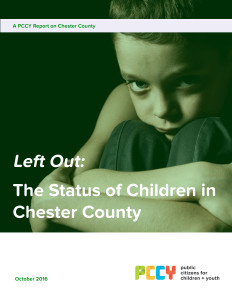Children Still in Recession in Chester County Despite Recovery
El aumento de la pobreza infantil y el menor rendimiento de los estudiantes ensombrecen los modestos logros
 Philadelphia (Oct 26, 2016) – While recent headlines tout a national recovery from the Great Recession, more children in Chester County are facing hardships than during the depths of the recession, a new study has found.
Philadelphia (Oct 26, 2016) – While recent headlines tout a national recovery from the Great Recession, more children in Chester County are facing hardships than during the depths of the recession, a new study has found.
Ciudadanos públicos para la infancia y la juventud [PCCY] anunció nuevas informes completos on the status of children in Philadelphia, Delaware, Montgomery, Bucks and Chester counties, entitled, “Left Out.” The Chester County report was released today.
“An American tragedy is happening right before our eyes, yet it’s very hard to see. The headline news touts a strong economic recovery, and monthly jobs reports amplify that message. But PCCY dug into the data and in Chester County found a very different and alarming story that does not bode well for children or the county,” said Donna Cooper, Executive Director of Public Citizens for Children and Youth.
The new PCCY “Left Out” series unveils a Child Wellness Index that measures if children are worse off or better with respect four domains: K-12 education, early childhood education, health and economic well-being. Compared to 2008 when the recession was just beginning, children in Chester County are faring worse in the economic well-being domain. Their health status has not improved, while their situation has improved minimally in the early childhood and K-12 education domains.
“It’s pretty startling that in eight of the 16 Index measures, children were faring worse in Chester County compared to 2008. Even where children are doing better, thousands of children are up against very bad odds,” said Cooper.
El repunte económico aún no llega a los niños
“It’s startling to see that even in one of the wealthiest U.S. counties, we have such a significant number of children growing up in poverty, and that the recovery has not reduced that number. The cost of living here is high so PCCY’s policy remedies become even more important, and engaging school districts is critical – not just because school lunch and breakfast programs are critical for poor children, but because there are still over 1,000 Chester County children without health insurance. No child should be without health insurance in Pennsylvania.” – Frances M. Sheehan, President and CEO, Brandywine Health Foundation
- Five years after the recession (2015), Chester County had a child poverty rate of 7.2%, or 8,542 children, still higher than the 5.5% at the start of the recession.
- Among the children in poverty, 2,847 are living in families earning less than half of the poverty level ($10,000 or less per year for a family of three), more children than are enrolled in the entire Octorara Area School District.
La mayoría de los distritos escolares tienen menos fondos incluso con más estudiantes que necesitan ayuda adicional
“We have some terrific school districts in Chester County, but each year we see more children who need extra help to succeed. And our ability to help them is hampered by a broad range of unfunded mandates and the state’s resistance to putting up its fair share of public school funding. That’s one reason we’ve seen district budgets across the county that require tax increases. As a school board member I know how hard it is to ask our neighbors to pay more in taxes. But we have little choice. We work very hard to run our district as efficiently as possible to keep taxes down. But I know that if a tax increase is necessary to ensure a high quality education, we have to do so. I can’t let down the children in my community. They come first.“ – Kate Shaw, School Board Director, West Chester Area School District
- By 2014, one in five public school students in the county were from low income families. Meanwhile, the elimination of Stimulus state and federal aid in FY 2011 meant that school districts had, overall, about $8,000 less per classroom to educate students in 2014, making Chester County the lowest spending suburban county.
- As a result, student performance declined. Nearly 6,200 third through eighth grade public school students could not pass state reading assessments in 2014, a full 17.7% of students in the county. This fail rate is about the same as in 2008, erasing all progress that had been made up to 2012. Progress in math was also lost, with 1,000 additional students failing compared to 2012.
Mejoró el acceso a experiencias de aprendizaje temprano de calidad, pero la mayoría de los niños pobres aún no reciben este comienzo inteligente
“Children soak up so much in their first five years, setting patterns that will help or hinder learning for the rest of their lives. It’s the most effective time for intervention – both in terms of cost and impact – especially for a child who shows a delay or disability, or whose life circumstances put her or him at risk. And evidence shows that typically developing, middle-class children also benefit enormously from high quality early childhood education. Yet so many children are missing their chance; that’s why we should advocate for investing more in kids.” – Dr. Joseph O’Brien, Executive Director, Chester County Intermediate Unit
- Young families are struggling with the rising costs of child care in Chester County, where three out of five children under six years old have all parents in the workforce. Full-time childcare for two children (a preschooler and an infant) rose 28% since 2008 to about $25,300, the most expensive of any suburban county.
- More children in publicly subsidized child care were in high quality programs in 2014 compared to 2008, but still two out of three cannot get access to those programs due to shortages in public funds. Meanwhile fewer children were able to enroll in publicly funded pre-k, with 84% of eligible children in the county unable to enroll in high quality pre-k due to lack of public funding, the largest share of any suburban county.
Spike in Uninsured Children and Disparities in Health Outcomes Stand in Way of Progress
“It’s heart-breaking and exasperating to tell a parent that we can help her apply for insurance for her baby but not for her nine year old son who does not have immigration papers. All Chester County children no matter where they were born should qualify for public health insurance. Both the moral and economic evidence is convincing.” – Alain Oliver, Executive Director, Maternal and Child Health Consortium of Chester County
- Despite reductions in the rate of uninsured children through the recession, the rate more than doubled in 2014 to 6.8%, making Chester County home to more uninsured children than any other suburban county. Many of these children don’t have the option to enroll because of the state’s ban on undocumented children’s access to public health insurance.
- Racial health disparities are becoming more dramatic. In 2015, 19% of white children were obese, while the rates for black and Hispanic children were more than twice as high at around 45%. Likewise, 5% of white children did not see a dentist in 2015 compared to 13% of black and 15% of Hispanic children.
La política pública ayudó a reducir la pobreza de las personas mayores, pero no lo hizo para los niños
- En todos los condados, la recesión económica afectó a miles de niños y adultos mayores, aumentando el número de personas en situación de pobreza en su punto más bajo. Pero a diferencia de las personas mayores, donde las políticas públicas efectivas les ayudaron a recuperarse más rápidamente en todos los condados suburbanos, los niños no recibieron las mismas protecciones. Estas políticas incluyen Medicare, Seguro Social, Cobertura de Medicamentos Recetados del Estado de Pensilvania (PACE), Reembolso de Rentas y Impuestos a la Propiedad de Pensilvania y políticas de impuestos estatales que excluyen las ganancias de jubilación de los impuestos estatales.
- From 2008 to 2015, the child poverty rate has been about 3 percentage points higher on average than the senior poverty rate in Chester County. In 2012, the senior poverty rate began to decline, two years earlier than the child poverty rate.
“These reports show good public policies are highly effective at changing life outcomes for children—in many instances they are the only tools that make a difference,” dijo Cooper. “Elected officials and their constituents have the opportunity to build the public will to adopt policies that protect children and strengthen the prospects of Chester County.”
Recomendaciones de política
- Aumente la longevidad del trabajo y el pago: Aumentar el salario mínimo e implementar apoyos para la fuerza laboral, incluida la programación predecible y la licencia por enfermedad y familiar pagada.
- Aumentar los ingresos del hogar: Conecte a las familias con los ingresos federales y apoyos laborales como el Crédito Tributario por Ingreso del Trabajo, el Crédito Tributario por Hijos y SNAP.
- Alimente a los niños hambrientos: Ampliar la participación en el programa de comidas escolares.
- Garantizar el acceso a la atención médica: Ampliar el seguro médico público para los niños indocumentados.
- Reduce Child Obesity: Create a pay for performance metric for Medicaid Managed Care Organizations that will increase health care provider focus on child obesity.
- Elimine el envenenamiento infantil con plomo: Asegurar que los proveedores de salud financiados con fondos públicos realicen pruebas a todos los niños menores de tres años; remediar los hogares de mujeres embarazadas con alto riesgo de peligros relacionados con el plomo.
- Aumentar la asistencia escolar: Mejorar la forma en que los proveedores de salud pública abordan el asma, incluidas las visitas domiciliarias para reducir los desencadenantes del asma en el hogar.
- Reduzca aún más la tasa de embarazo adolescente: Aumentar el acceso a métodos anticonceptivos de acción prolongada para adolescentes con Medicaid.
- Amplíe el alcance de la intervención temprana: Ampliar el uso de herramientas de detección temprana para identificar a todos los niños que necesitan servicios de intervención temprana.
- Haga que el cuidado infantil de calidad sea asequible: Utilice los recursos del estado y del condado para incentivar a los proveedores a mejorar la calidad y permitir que los proveedores que ya son de alta calidad se expandan.
- Expandir Pre-K: Incrementar la inversión estatal en prekínder para crear un asiento para cada niño elegible.
- Aumente el acceso al jardín de infantes de día completo: Eliminar las barreras financieras que limitan la capacidad de los distritos escolares para ofrecer kindergarten de día completo.
- Abordar la crisis de financiación escolar: Aumentar los fondos estatales para las escuelas públicas y distribuir esos fondos a través de la Fórmula de financiación de la educación básica.
Enlaces y gráficos
See the full Chester County report at: https://www.childrenfirstpa.org/wp-content/uploads/2016/10/PCCY-PR-LeftOut-ChesterCounty.pdf
See and share Chester County indicators graphics at: https://www.childrenfirstpa.org/resource/left-chester-county-indicators/
Vea los informes de los cinco condados en: https://www.childrenfirstpa.org/report/left-regional-reports-child-well/
